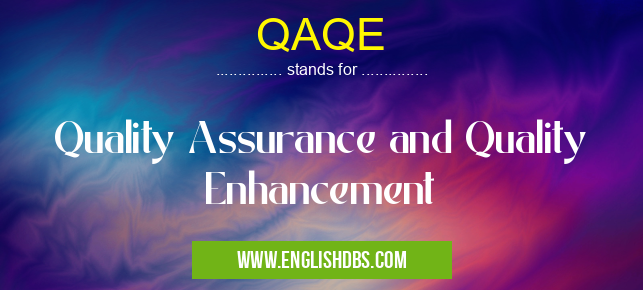What does QAQE mean in UNCLASSIFIED
Quality Assurance and Quality Enhancement (QAQE) is a systematic process that helps organizations to improve the quality of their products, services, and processes.

QAQE meaning in Unclassified in Miscellaneous
QAQE mostly used in an acronym Unclassified in Category Miscellaneous that means Quality Assurance and Quality Enhancement
Shorthand: QAQE,
Full Form: Quality Assurance and Quality Enhancement
For more information of "Quality Assurance and Quality Enhancement", see the section below.
QAQE involves two primary activities:
- Quality assurance focuses on preventing defects and errors from occurring by establishing and implementing quality standards and processes.
- Quality enhancement aims to improve the quality of existing products, services, or processes by identifying and eliminating inefficiencies and non-value-added activities.
Purpose of QAQE
The primary purpose of QAQE is to:
- Ensure that products or services meet or exceed customer requirements and expectations.
- Improve operational efficiency and effectiveness by reducing waste and rework.
- Enhance customer satisfaction and loyalty.
- Mitigate risks associated with non-compliant products or services.
QAQE Process
The QAQE process typically involves the following steps:
- Planning: Establish quality goals, objectives, and requirements.
- Implementation: Develop and implement quality standards, processes, and controls.
- Monitoring: Regularly assess the effectiveness of quality management systems and processes.
- Improvement: Identify opportunities for continuous improvement and implement corrective actions.
Essential Questions and Answers on Quality Assurance and Quality Enhancement in "MISCELLANEOUS»UNFILED"
What is the main goal of QAQE?
The primary objective of QAQE (Quality Assurance and Quality Enhancement) is to ensure that educational institutions maintain and improve the quality of their programs, services, and operations. It involves ongoing monitoring, evaluation, and implementation of improvement strategies to enhance student outcomes and overall academic excellence.
What are the key components of QAQE?
QAQE typically encompasses several key components, including:
- Quality Assurance: Involves establishing and maintaining standards for educational programs and services, ensuring compliance with regulations, and implementing quality management systems.
- Quality Enhancement: Focuses on continuous improvement by identifying areas for enhancements, developing and implementing improvement plans, and assessing the effectiveness of these plans.
- Monitoring and Evaluation: Involves collecting, analyzing, and interpreting data to track performance, identify strengths and weaknesses, and inform decision-making for quality improvement.
How does QAQE benefit students?
QAQE plays a vital role in ensuring that students receive high-quality education. It helps maintain program standards, enhances teaching effectiveness, and improves the overall learning environment. By focusing on quality assurance and enhancement, students benefit from:
- Improved academic rigor and learning outcomes.
- Enhanced support services and resources.
- Greater opportunities for personal and professional growth.
What are the challenges in implementing QAQE?
Implementing QAQE effectively can come with certain challenges, such as:
- Resource constraints: Limited funding, staff, or time can hinder the implementation of comprehensive QAQE initiatives.
- Resistance to change: Faculty and staff may resist changes to established practices, making it challenging to implement new quality improvement strategies.
- Data collection and analysis: Gathering and interpreting meaningful data to inform decision-making can be complex and time-consuming.
What are the best practices for successful QAQE implementation?
To ensure successful implementation of QAQE, institutions can adopt best practices such as:
- Leadership commitment: Strong leadership support is crucial for creating a culture of quality and fostering continuous improvement.
- Collaborative approach: Involving faculty, staff, students, and stakeholders in the QAQE process promotes shared ownership and accountability.
- Data-driven decision-making: Relying on data to identify areas for improvement and inform decision-making ensures evidence-based quality enhancement.
- Continuous improvement cycle: Establishing a cycle of monitoring, evaluation, and improvement ensures ongoing progress and sustainability.
Final Words: QAQE is a valuable tool for organizations seeking to improve the quality of their products, services, and processes. By implementing a comprehensive QAQE program, organizations can enhance customer satisfaction, increase operational efficiency, and reduce risks associated with non-compliant products or services.
